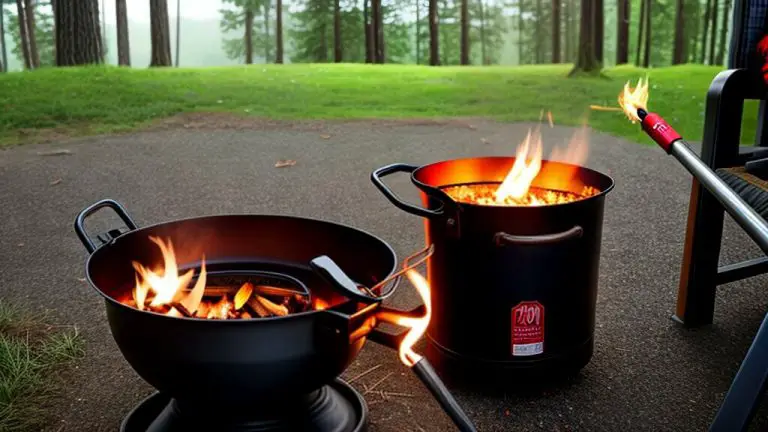Whether you need to light a candle, start a fire, or spark up a conversation, a Bic lighter is a trusted tool. But do you know how to use one properly? In this guide, we’ve compiled a comprehensive step-by-step process for using a Bic lighter safely and efficiently; also, we know how fire is from a lighter.
It’s important to follow these instructions carefully to avoid accidents and ensure optimal performance. Let’s get started.
Key Takeaways:
- Using a Bic lighter correctly is essential for safe and efficient ignition.
- Proper usage includes understanding safety features, holding the lighter correctly, igniting it safely, adjusting flame intensity, extinguishing the flame, refilling the lighter, and maintaining it.
- Common mistakes can cause accidents or damage, so following the instructions carefully is essential.
Understanding Bic Lighter Safety Features
Before using a Bic lighter, it is crucial to understand its safety features to prevent accidents or harm. Bic lighters come equipped with a child-resistant mechanism that helps prevent children from accidentally igniting them. To use a Bic lighter, you need to press the ignition button while turning the thumbwheel in a clockwise direction to create a spark.
Additionally, Bic lighters feature an adjustable flame, allowing you to control the flame’s intensity. Turn the flame adjustment dial at the bottom of the lighter to adjust the flame. The dial moves clockwise to increase the flame height or anti-clockwise to decrease it.
It is essential to use these safety features properly to avoid accidents. Ensure the child-resistant mechanism is in place when not used, and never leave a lit Bic lighter unattended. Always adjust the flame height according to your requirements and handle the lighter cautiously, especially around flammable materials.
Holding the Bic Lighter Correctly
Before using a Bic lighter, it’s important to know how to hold it correctly. This ensures the lighter is stable and comfortable, making ignition easier and safer.
To hold a Bic lighter correctly:
- Place your index finger on the trigger, with your thumb on the thumbwheel.
- Wrap your remaining fingers around the lighter’s body, ensuring a firm grip.
- Position your hand so that your thumb faces upward and your index finger points toward the flame.
By following these simple tips, you can ensure a stable and comfortable hold on your Bic lighter, making usage easy and safe.
Igniting the Bic Lighter
Now that you properly grip the Bic lighter, it’s time to ignite the flame. To do so, you’ll need to use the thumbwheel near the lighter’s bottom. The thumbwheel creates friction against a small flint rod, producing a spark that ignites the fuel.
Before attempting to light the lighter, make sure your fingers are clear of the flame area and that the lighter is pointed away from your face and any flammable materials.
With your thumb, slowly and firmly roll the thumbwheel away from you while holding the lighter steady with your other hand. You should see a small spark produced by the flint rod, and the fuel should ignite almost immediately.
If you have difficulty producing a spark or getting the flame to ignite, try adjusting the flame height (explained in the next section), or check that the lighter’s fuel isn’t running low.
It’s important to note that holding the thumbwheel down for an extended period can damage the lighter and cause it to overheat. Make sure to release the thumbwheel once the flame has been established, and never leave the lighter unattended while the flame is still burning.
Adjusting the Flame Intensity
Adjusting the flame intensity on a Bic lighter is essential for optimal usage. The flame adjustment dial located at the bottom of the lighter can increase or decrease the size of the flame.
To increase the flame, turn the dial clockwise. To decrease the flame, turn the dial counterclockwise. Finding the perfect flame height may require trial and error, but it is crucial to ensure that the flame is not too high, which can be dangerous or too low, making ignition difficult.
It is essential to adjust the flame after the initial ignition. If you need to adjust the flame while the lighter is still lit, use a pair of pliers to avoid burning your fingers. Hold the pliers near the base of the flame adjustment dial and turn it as needed.
Extinguishing the Bic Lighter
Properly extinguishing a Bic lighter is crucial for safety and ensures that the lighter lasts as long as possible.
Follow these steps to extinguish your Bic lighter safely:
- Release the thumbwheel by releasing your thumb from it.
- Wait until the flame goes out completely.
- Check that the lighter is no longer hot to the touch before storing it.
Avoid blowing out the lighter, as this could cause sparks or hot embers that could start a fire. Also, avoid dropping the lighter on the ground after use, as this could damage or cause a fire.
Refilling a Bic Lighter
Refilling your Bic lighter is a simple process that can extend the life of your lighter. The most important thing to remember is to use the correct fuel to avoid damaging the lighter.
To refill the lighter:
- Hold the lighter upside down and locate the refill valve on the bottom.
- Insert the nozzle of the fuel canister into the valve and apply firm pressure for 5 to 6 seconds. Be careful not to overfill.
- Remove the fuel canister and wait 2 minutes before using the lighter to allow the fuel to settle.
It is recommended to use only butane fuel specifically designed for lighters. Other fuel types, such as propane or gasoline, can damage the lighter or cause it to malfunction. It is also important to avoid overfilling the lighter, as this can cause leakage or other issues.
Maintaining a Bic Lighter
To ensure your Bic lighter performs at its best, it is important to maintain it properly. Follow these tips for optimal performance:
| Maintenance Task | Frequency |
|---|---|
| Cleaning | As needed |
| Storing | When not in use |
| Replacing the Flint | As needed |
| Refilling with Butane | As needed |
Cleaning your Bic lighter regularly will help to remove any debris or residue that may accumulate and interfere with its performance. Use a soft, dry cloth to wipe down the lighter’s exterior and the cap’s inside. Avoid using water or any harsh chemicals that may damage the lighter.
Storing your Bic lighter in a cool, dry place when not in use will help to protect it from damage and keep it working properly. Avoid exposing the lighter to extreme temperatures or direct sunlight, which can cause the plastic to warp or crack.
It is important to replace the flint in your Bic lighter as needed to ensure it continues producing sparks and igniting properly. Remove the screw at the bottom of the lighter to replace the flint, and carefully slide out the used flint. Insert the new flint and replace the screw.
When refilling your Bic lighter with butane, be sure to use a high-quality fuel specifically designed for lighters. Follow the manufacturer’s instructions for refilling, and do not overfill the lighter, as this can cause leaks or other issues.
By following these tips for maintaining your Bic lighter, you can ensure it is always ready to use when needed.
Bic Lighter Tips and Tricks
BIC lighters are versatile tools that can be used for more than just lighting candles and cigarettes. Here are some tips and tricks to make the most out of your Bic lighter:
- Use the flame to seal the ends of the rope or nylon cord to prevent fraying.
- Heat a stuck zipper to make it easier to move.
- Create a DIY wax seal by melting a candle over an envelope and stamping it with a seal.
- Use the flame to remove stubborn stickers or labels from surfaces.
- Warm up a cold key before trying to insert it into a lock.
- Light a mesh scrubber to quickly and easily start a campfire.
- Use the lighter to melt the ends of a synthetic shoelace to prevent fraying.
- Warm up a spoon before scooping out ice cream to make it easier.
Remember always to practice safety when using your Bic lighter for non-traditional purposes.
“A Bic lighter can be a handy tool for more than just lighting candles. Use it to seal the ends of rope, heat up a stuck zipper, or create a wax seal for an envelope.” – The Spruce Crafts
Common Mistakes to Avoid When Using a Bic Lighter
While using a Bic lighter may seem straightforward, common mistakes can lead to accidents or damage. Here are some mistakes to avoid:
- Not using the child-resistant mechanism: Bic lighters have a child-resistant mechanism to prevent accidental ignition. Using this feature and keeping the lighter out of children’s reach is essential.
- Adjusting the flame too high: Setting the flame too high can cause burns or damage to the lighter. Follow the safety instructions to adjust the flame to the desired height and avoid going too high.
- Using the lighter for extended periods: A Bic lighter is not designed for long periods of use. Avoid using it as a replacement for a stove or candle and use it only for its intended purpose.
- Not extinguishing the flame completely: Always ensure the flame is entirely out before storing or disposing of the lighter. Failure to do so can cause fires or dangerous situations.
- Not refilling the lighter correctly: If you plan to refill your lighter, use the appropriate fuel and follow the instructions. Incorrect refilling can cause damage to the lighter or cause accidents.
- Not checking the lighter before use: Inspect it before each use to ensure it’s in proper working condition. A damaged or worn-out lighter can be dangerous and should be replaced.
By avoiding these common mistakes, you can ensure the safe and efficient use of your Bic lighter.
Conclusion
Proper usage of a Bic lighter is crucial for safe and efficient ignition. By following our step-by-step guide and understanding the safety features, you can ensure that your Bic lighter serves you well. Remember to hold the lighter correctly, ignite it safely, adjust the flame intensity as needed, and extinguish it properly.
Refilling your Bic lighter and maintaining it is also important for optimal performance. Cleaning, storing, and replacing worn-out parts is key to keeping your lighter in shape.
Additionally, try out our tips and tricks for creatively using your Bic lighter and impressing others with your skills. But remember to avoid common mistakes that can lead to accidents or damage your lighter.
In summary, Bic lighters are versatile tools that can be used for various purposes, but safety should always be a top priority. By practicing safe usage and exploring the capabilities of your Bic lighter, you can enjoy its convenience and reliability for a long time to come.

I’m Alfred Davis, and I’m all about lighters. Hailing from the great state of Texas, USA, I’ve cultivated a deep passion for these fascinating gadgets. With years of hands-on experience and a burning curiosity (pun intended), I’ve become an expert in all things related to lighters.
My journey with lighters began as a hobby and quickly became a full-blown obsession. I’ve explored the diverse world of lighters inside and out, from classic Zippo designs to modern plasma arc models. I’ve tested, tinkered with, and even collected rare pieces while learning the intricate mechanics and unique histories behind each one.
Through my writing, I aim to share my knowledge, insights, and reviews to help you make informed decisions about choosing the perfect lighter. Whether you’re a seasoned collector or just looking for a reliable fire source, I’ve got you covered. Join me in unraveling the fascinating realm of lighters right here at LightersInfo, where ignition meets expertise.
Alfred Davis

